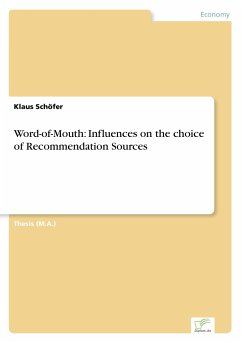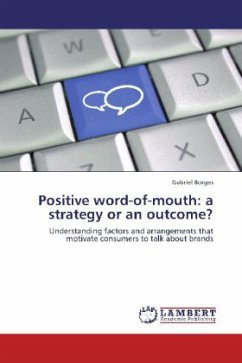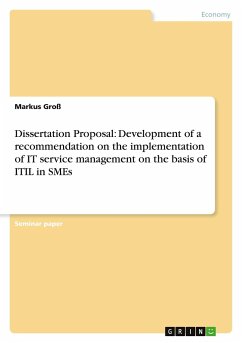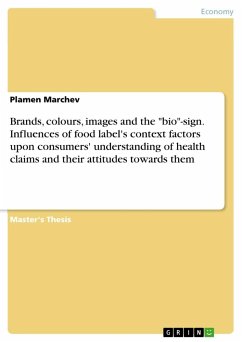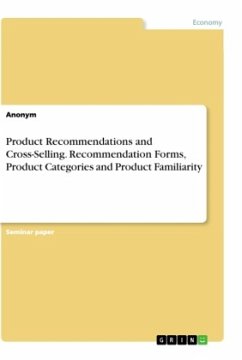Thesis (M.A.) from the year 1998 in the subject Business economics - Marketing, Corporate Communication, CRM, Market Research, Social Media, grade: 1,3, University of Nottingham (Business School), language: English, abstract: Inhaltsangabe:Abstract:
The idea of understanding consumer behaviour as a sequential decision-making process is one that is common in marketing. The decision-making process itself is presented as a logical flow of activities, working from problem recognition to purchase to post-purchase evaluation. This decision-making process is affected by a number of other more complex influences. Some of these influences relate to the wider environment in which the decision is being made while others relate to the individual who makes the decision.
In this context, .. [o]ne of the most widely accepted notions in consumer behavior is that word-of-mouth communication (hereafter WOM) plays an important role in shaping consumers' attitudes and behaviors. More specifically, WOM communications between consumers are a topic of interest in both the pre-purchase and post-purchase decision-making literature. Research into the diffusion of innovations has focused on modelling the role of WOM in product adoption at various stages of the diffusion process. WOM has also been studied as a mechanism through which consumers convey both informational and normative influences in the product evaluation. Finally, WOM has been identified as an important post-purchase complaining option.
Although WOM plays an important role in consumer pre-purchase and post-purchase decision-making, research into this phenomenon has been fragmented. Importantly, relatively little attention has been directed at understanding key issues with respect to WOM recommendation sources and the factors that influence their use. The aim of the present work is to add to this small body of empirical research.
The main part of this paper is divided into two chapters. Chapter 2, that follows an introduction to the work, is a theoretical one. It is a review of the literature on consumer decision-making and the individual and environmental influences on it. Emphasis is being placed on WOM communication and its role in understanding consumer behaviour. Chapter 3 focuses on the choice of WOM recommendation sources. Empirical research is presented which explores the influences on the choice over WOM recommendation sources. Finally, concluding remarks and recommendations for further research can be found in chapter 4.
Inhaltsverzeichnis:Table of Contents:
Chapter 1: Introduction1
Chapter 2: Literature Review3
2.1Consumer Decision-Making3
2.1.1The Decision-Making Process4
2.1.1.1Problem Recognition5
2.1.1.2Information Search6
2.1.1.3Evaluation of Alternatives8
2.1.1.4Purchase9
2.1.1.5Post-Purchase Evaluation10
2.1.2Individual Influences12
2.1.3Environmental Influences15
2.1.3.1Culture15
2.1.3.2Social Class16
2.1.3.3Reference Groups16
2.2Word-of-Mouth Communication20
2.2.1Definition20
2.2.2Scope and Significance20
2.2.3Characteristics of WOM22
2.2.4The Nature of WOM24
2.2.4.1Types24
2.2.4.2Process24
2.2.4.3Conditions28
2.2.4.4Motives29
2.2.5WOM and the Consumer Behaviour Literature30
2.2.5.1Adoption and Diffusion on Innovations30
2.2.5.2Post-Purchase Decision-Making31
2.2.5.3Pre-Purchase Decision-Making33
Chapter 3: Empirical Analysis34
3.1The Model34
3.1.1Recommendation Sources34
3.1.2Evaluative Cues35
3.1.3Task Difficulty36
3.1.4Prior Knowledge37
3.1.5Hypotheses39
3.2Research Context43
3.3Method45
3.3.1Research Instrument45
3.3.2Procedure47
3.3.3Sample48
3.4Results50
3.5Discussion57
3.6Limitations61
Chapter 4: Conclusion62
Appendix A
Appendix B
References
Hinweis: Dieser Artikel kann nur an eine deutsche Lieferadresse ausgeliefert werden.
The idea of understanding consumer behaviour as a sequential decision-making process is one that is common in marketing. The decision-making process itself is presented as a logical flow of activities, working from problem recognition to purchase to post-purchase evaluation. This decision-making process is affected by a number of other more complex influences. Some of these influences relate to the wider environment in which the decision is being made while others relate to the individual who makes the decision.
In this context, .. [o]ne of the most widely accepted notions in consumer behavior is that word-of-mouth communication (hereafter WOM) plays an important role in shaping consumers' attitudes and behaviors. More specifically, WOM communications between consumers are a topic of interest in both the pre-purchase and post-purchase decision-making literature. Research into the diffusion of innovations has focused on modelling the role of WOM in product adoption at various stages of the diffusion process. WOM has also been studied as a mechanism through which consumers convey both informational and normative influences in the product evaluation. Finally, WOM has been identified as an important post-purchase complaining option.
Although WOM plays an important role in consumer pre-purchase and post-purchase decision-making, research into this phenomenon has been fragmented. Importantly, relatively little attention has been directed at understanding key issues with respect to WOM recommendation sources and the factors that influence their use. The aim of the present work is to add to this small body of empirical research.
The main part of this paper is divided into two chapters. Chapter 2, that follows an introduction to the work, is a theoretical one. It is a review of the literature on consumer decision-making and the individual and environmental influences on it. Emphasis is being placed on WOM communication and its role in understanding consumer behaviour. Chapter 3 focuses on the choice of WOM recommendation sources. Empirical research is presented which explores the influences on the choice over WOM recommendation sources. Finally, concluding remarks and recommendations for further research can be found in chapter 4.
Inhaltsverzeichnis:Table of Contents:
Chapter 1: Introduction1
Chapter 2: Literature Review3
2.1Consumer Decision-Making3
2.1.1The Decision-Making Process4
2.1.1.1Problem Recognition5
2.1.1.2Information Search6
2.1.1.3Evaluation of Alternatives8
2.1.1.4Purchase9
2.1.1.5Post-Purchase Evaluation10
2.1.2Individual Influences12
2.1.3Environmental Influences15
2.1.3.1Culture15
2.1.3.2Social Class16
2.1.3.3Reference Groups16
2.2Word-of-Mouth Communication20
2.2.1Definition20
2.2.2Scope and Significance20
2.2.3Characteristics of WOM22
2.2.4The Nature of WOM24
2.2.4.1Types24
2.2.4.2Process24
2.2.4.3Conditions28
2.2.4.4Motives29
2.2.5WOM and the Consumer Behaviour Literature30
2.2.5.1Adoption and Diffusion on Innovations30
2.2.5.2Post-Purchase Decision-Making31
2.2.5.3Pre-Purchase Decision-Making33
Chapter 3: Empirical Analysis34
3.1The Model34
3.1.1Recommendation Sources34
3.1.2Evaluative Cues35
3.1.3Task Difficulty36
3.1.4Prior Knowledge37
3.1.5Hypotheses39
3.2Research Context43
3.3Method45
3.3.1Research Instrument45
3.3.2Procedure47
3.3.3Sample48
3.4Results50
3.5Discussion57
3.6Limitations61
Chapter 4: Conclusion62
Appendix A
Appendix B
References
Hinweis: Dieser Artikel kann nur an eine deutsche Lieferadresse ausgeliefert werden.

